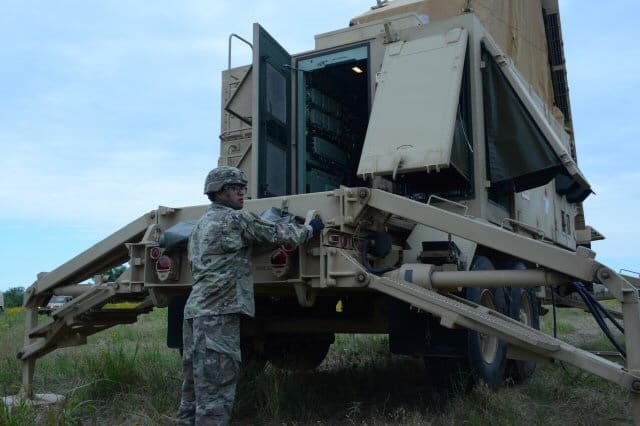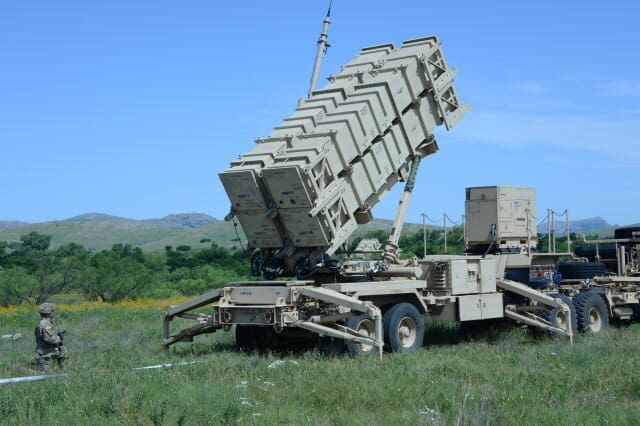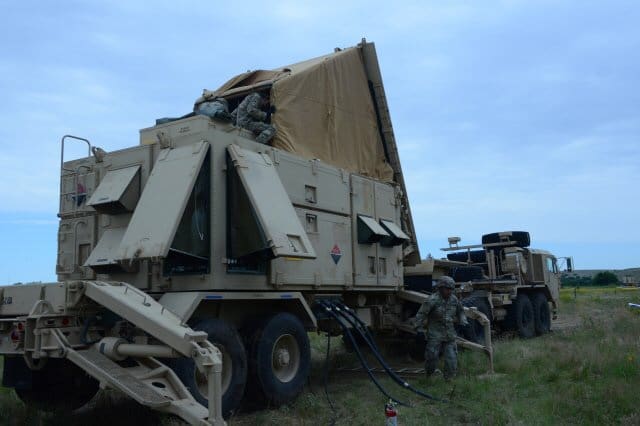FORT SILL, Okla. — The Army completed on Monday an almost three-month-long capabilities demonstration of prototype radars aimed at replacing the one currently used by Patriot missile units.
The “sense-off” at White Sands Missile Range, New Mexico, tested three different prototypes of the Lower Tier Air and Missile Defense Sensor, or LTAMDS. The radars tracked simulated incoming missiles and live aircraft scenarios as experts observed their capabilities.
A board will convene to evaluate the data collected and the test results to select a single vendor for the LTAMDS contract by Sept. 30, said Terry Young, senior advisor to the director of the Air and Missile Defense Cross-Functional Team of Army Futures Command, Brig. Gen. Brian Gibson.

“We’re pleased with the conduct of the competition so far; many stellar Soldiers and civilians from varied organizations across our Army came together and worked very hard as a team to ensure a fair and thorough competition was conducted,” Young said. He made three trips out to White Sands this spring to observe each of the three vendors’ prototypes in action.

The plan is to field the new radar to the first Patriot battalion by the 4th quarter of fiscal year 2022, Young said. Eventually 15 battalions will be fielded by the end of FY 2031.
“The Patriot system has been around since the late ’70s,” he said, explaining that the radar system has been patched and updated continuously to keep pace with evolving threats over the last 40 years.

“Industry, technicians and our Patriot Soldiers have done wonders to keep the system updated to where it’s at today,” he said of the Patriot radar, but added that technology has grown by “leaps and bounds” over the past few years. “It’s time to get a new radar out there to keep up with the future fight,” he said.
With the proliferation of unmanned aerial systems and new technologies by near-peer nations such as China and Russia, U.S. air superiority on a future battlefield can no longer be taken for granted, Young said. This places increased importance on air and missile defense, he explained.
The LTAMDS is the No. 4 program of the four efforts the Air and Missile Defense CFT is currently working on, he said.
MSHORAD
The No. 2 priority program is the Maneuver Short Range Air Defense System, or MSHORAD, a new Stryker variant with a turret that will hold two hellfire missiles encased in an external pod, an M230LF 30mm chain gun, a 7.62 machine gun and another external pod housing four Stinger missiles.
The first five MSHORAD prototypes are on schedule to be delivered to the Army for testing beginning in October, Young said. The Army Test and Evaluation Command will “put it through the gamut and Soldiers will eventually be placed on the system to give their feedback through a series of touchpoints,” he said of the new weapon system.
The Army Futures Command, the acquisition community, AMD CFT and the Air Defense community are all very proud of the MSHORAD program and consider it a great example of teamwork and a “quick win” for the Army, Young said. By the second quarter of FY 23, the goal is to have 144 of the MSHORAD systems off the assembly line to field four complete battalions.
‘IRON DOME‘
The No. 3 priority program the CFT is working on is the Indirect Fire Protection Capability, or IFPC, to defeat everything from rockets and mortars to incoming cruise missiles.
“Right now, we’re thinking ‘Iron Dome’ offers the best solution for an initial capability for IFPC,” Young said. Iron Dome is an air defense system used by Israel effectively in over 1,900 combat engagements, he said. Further testing and experimentation with the Iron Dome System and its components will take place and help inform the Army’s enduring solution for IFPC, he said.
Young was part of a team that that went to Israel earlier this year to get briefed and observe the Iron Dome and its capabilities in action. The team included the AMD CFT director, the Air Defense Artillery School commandant and elements from Program Executive Office Missiles and Space.
The U.S. is currently negotiating with Israel for a contract to purchase two batteries of the Iron Dome system. These will be tested to see if the system can bridge the gap between the MSHORAD and the Patriot in order to protect high-value, fixed and semi-fixed assets, Young said.
BATTLE COMMAND SYSTEM
Currently, the No. 1 priority of the CFT is the Integrated Air and Missile Defense Battle Command System or IBCS, Young said. This system has made great progress in the last couple of years and recently became the responsibility of the CFT.
IBCS is a critical program for Air Defense and many other programs depend on its success, he said. “Many agencies and Soldiers are working hard on it and we have high expectations for a successful program,” he said.
A limited user test, or LUT, for the IBCS is planned for next spring at White Sands Missile Range.
The main objective of the AMD CFT is to cut the acquisition time for future weapon systems and equipment in half or less, “while at the same time ensuring a quality product that is cost-efficient and safe gets into the hands of our Soldiers,” Young said.
By Gary Sheftick, Army News Service

